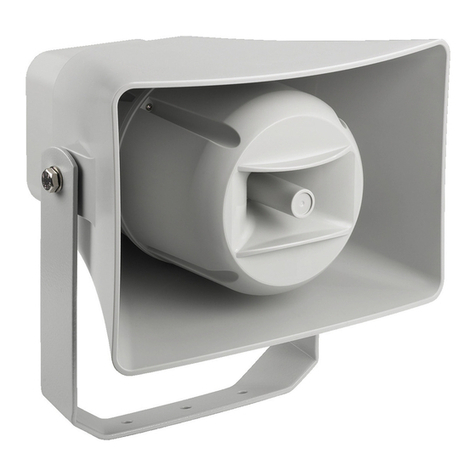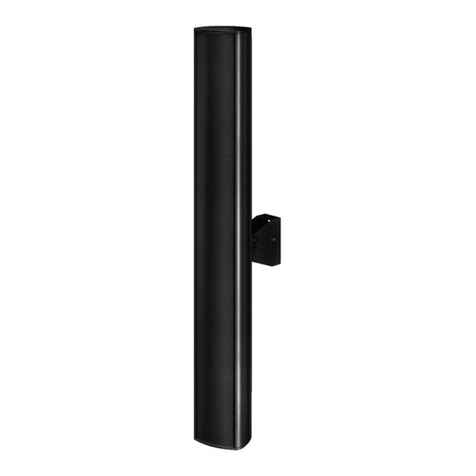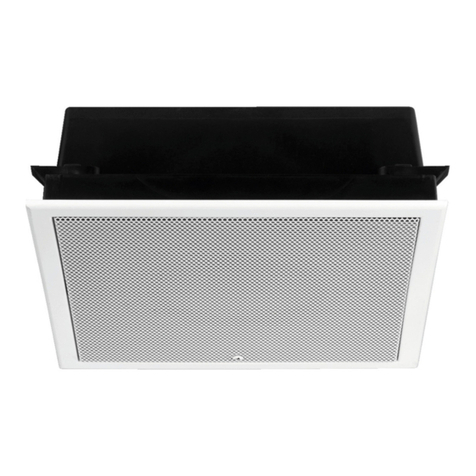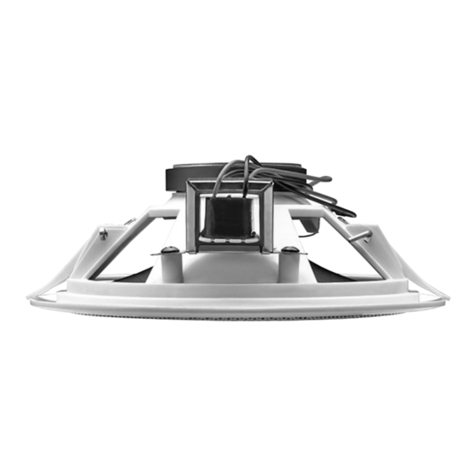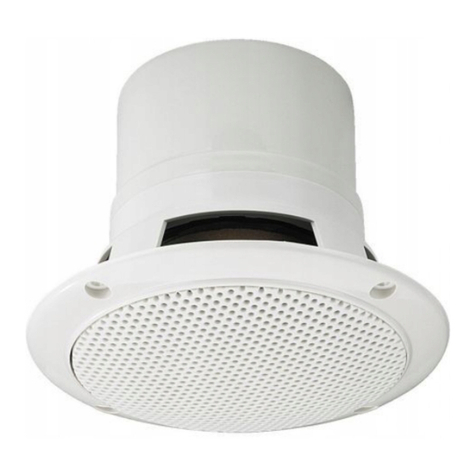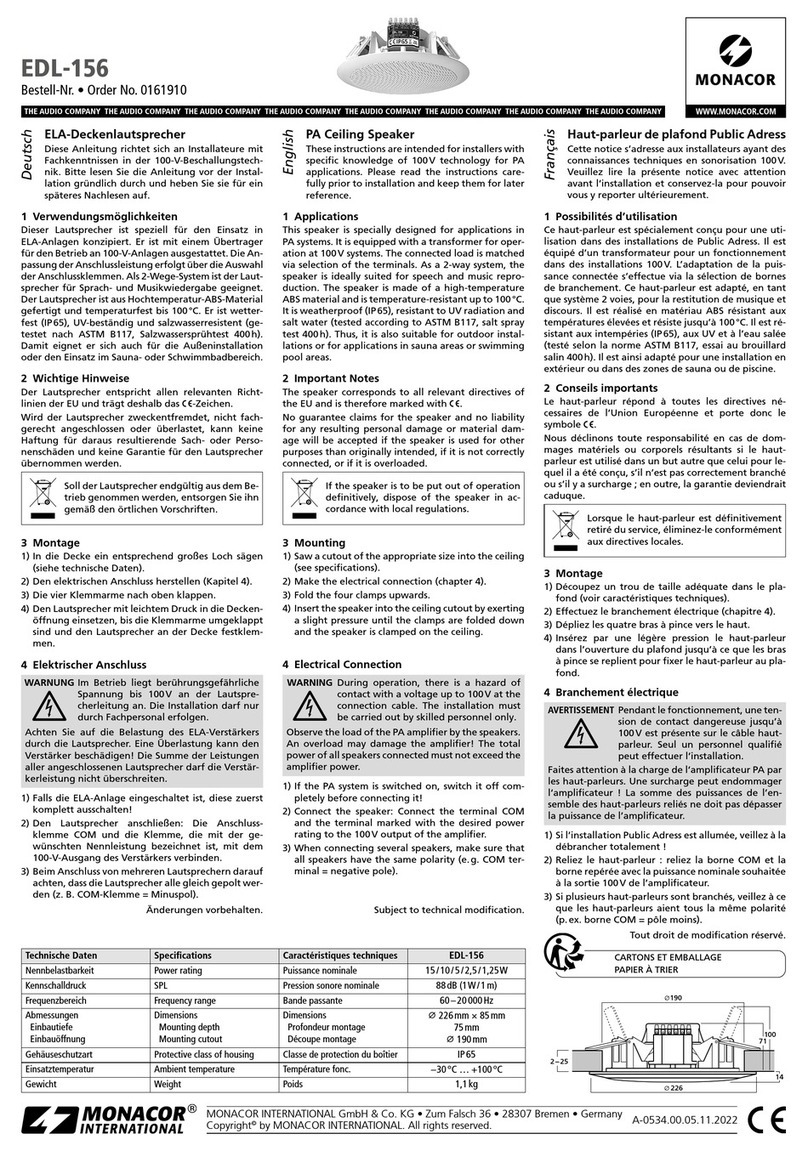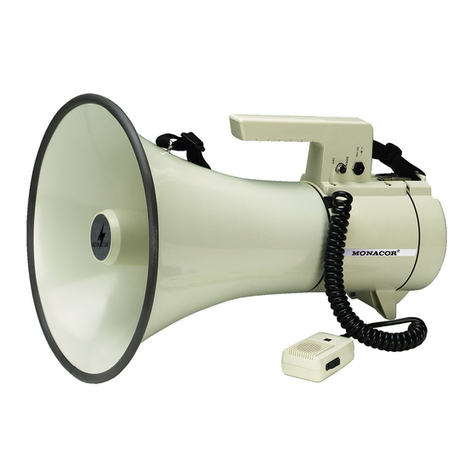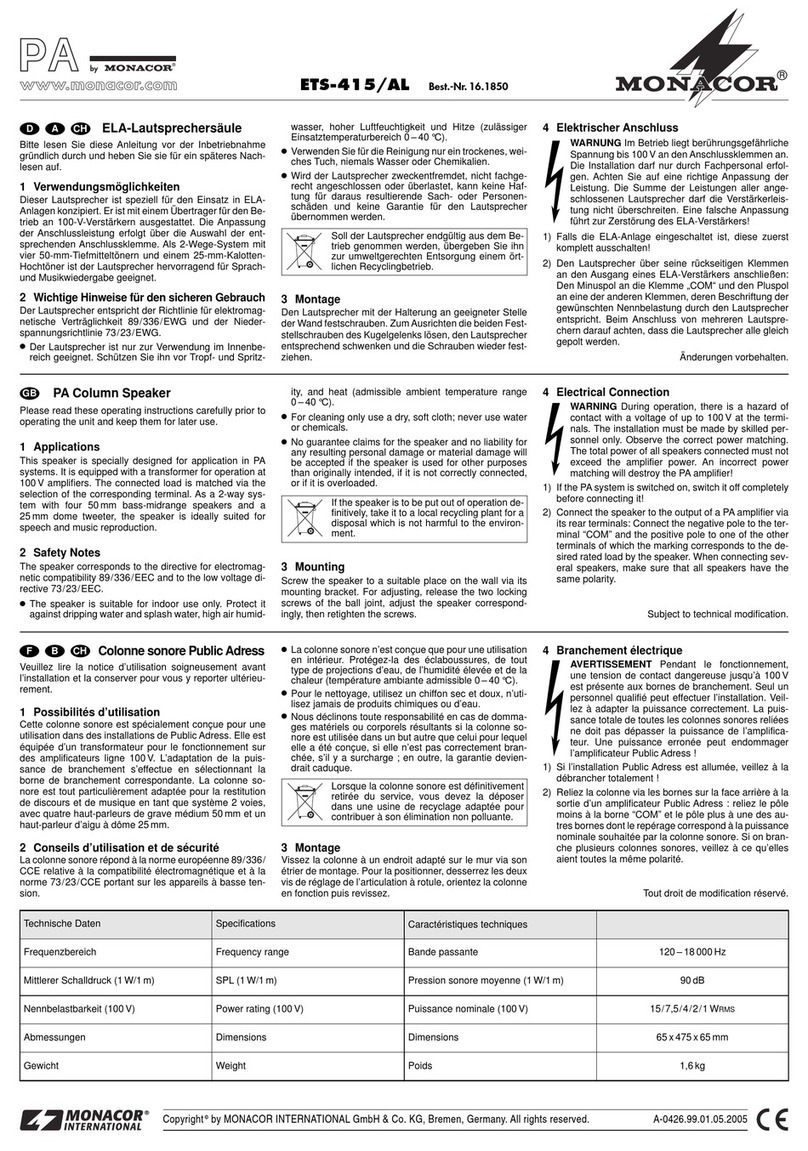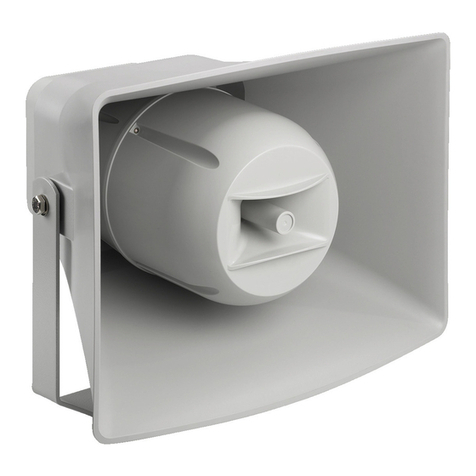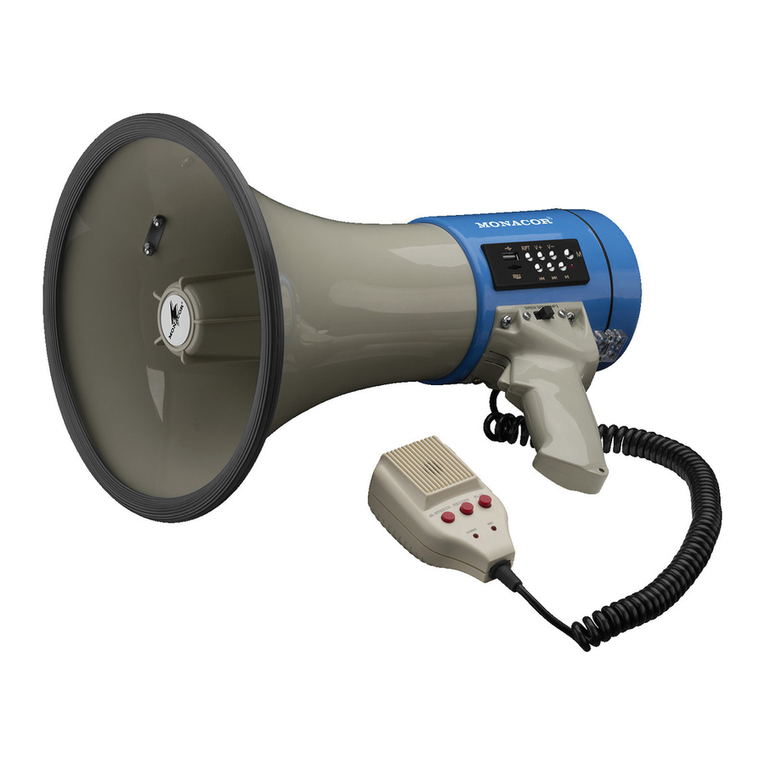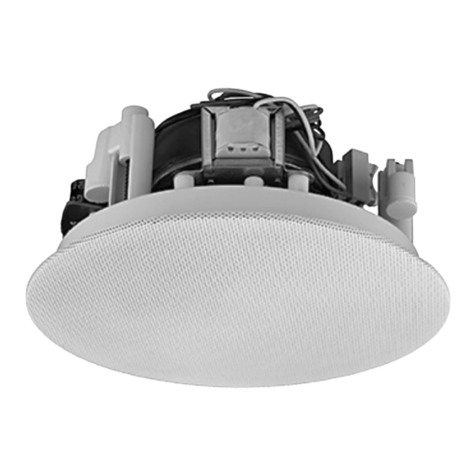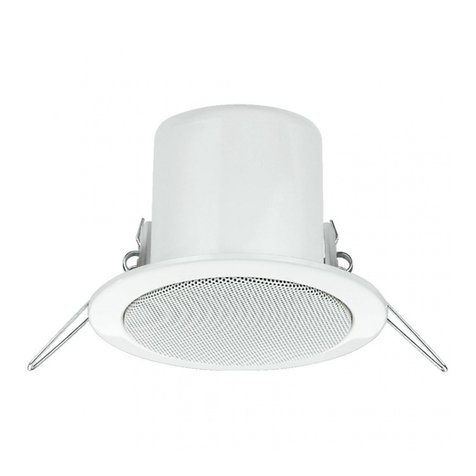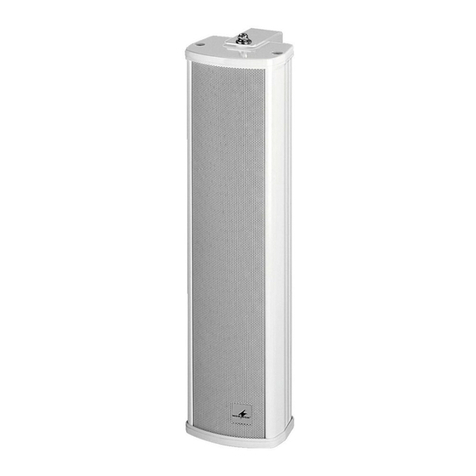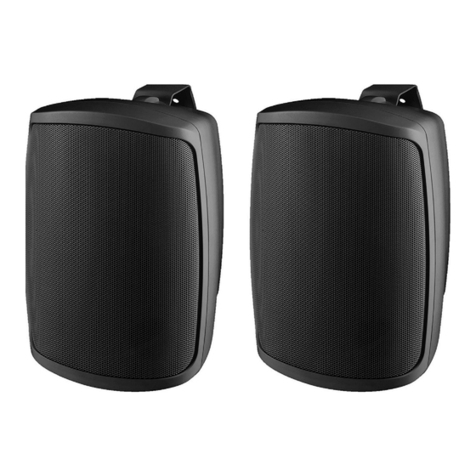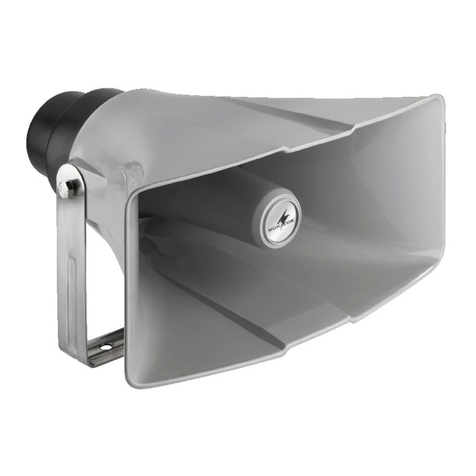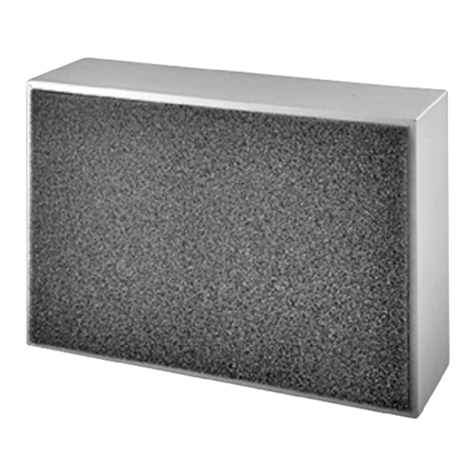®
Haut-parleur de plafond Public Adress
Veuillez lire la présente notice avec attention avant
lʼinstallation et conservez-la pour pouvoir vous y
reporter ultérieurement.
1 Possibilités dʼutilisation
Ce haut-parleur sert pour des applications de Public
Adress en sonorisation de discours et musique de
fond. Il est spécialement conçu pour une utilisation
dans des installations de Public Adress fonctionnant
en ligne 100 V. La conception du haut-parleur en deux
éléments (cadre de maintien et haut-parleur) facilite
grandement le montage.
2 Conseils importants dʼutilisation
Le haut-parleur répond à toutes les directives néces-
saires de lʼUnion Européenne et porte donc le sym-
bole .
GLʼappareil nʼest conçu que pour une utilisation en
intérieur. Protégez-le des éclaboussures, de tout
type de projections dʼeau, dʼune humidité dʼair éle-
vée et de la chaleur (température ambiante admis-
sible 0 – 40 °C).
GPour le nettoyage, utilisez uniquement un chiffon
sec et doux, en aucun cas de produits chimiques ou
dʼeau.
GNous déclinons toute responsabilité en cas de dom-
mages matériels ou corporels résultants si le haut-
parleur est utilisé dans un but autre que celui pour
lequel il a été conçu, sʼil nʼest pas correctement
monté, branché ou sʼil y a surcharge ; en outre, la
garantie deviendrait caduque.
3 Montage
1) Tournez le haut-parleur jusquʼà la butée de telle
sorte quʼil puisse être retiré du cadre de maintien.
2) Poussez vers le haut les trois ressorts du
cadre pour serrer et faites-les entrer dans
lʼencoche (flèche).
PRECAUTION ! Il y a risque de blessure à
cause des forces des ressorts lorsque vous
les serrez et les relâchez (point de mon-
tage 4). Ne mettez jamais vos doigts entre
le cadre et les ressorts sous tension.
3) Découpez un trou de diamètre 200 mm dans le pla-
fond.
4) Placez le cadre de montage dans le trou du plafond
et desserrez avec précaution les ressorts de leur
encoche pour quʼils rebondissent et maintiennent
le cadre dans le plafond.
5) Fixez la corde du haut-parleur dans lʼintérieur du
plafond ou sur le cadre (par exemple sur lʼencoche
dʼun ressort) pour que le haut-parleur ne puisse
pas tomber.
6) Effectuez le branchement comme décrit dans le
chapitre 4.
Lorsque le haut-parleur est définitivement
retiré du service, vous devez le déposer dans
une usine de recyclage adaptée pour contri-
buer à son élimination non polluante.
7) Placez le haut-parleur dans le cadre et tournez jus-
quʼà la butée pour bien le maintenir.
4 Branchement électrique
1) Avant dʼeffectuer les branchements électriques du
haut-parleur, débranchez complètement lʼinstalla-
tion Public Adress pour que le câble audio 100 V de
lʼamplificateur PAne soit pas conducteur de tension.
2) Reliez le haut-parleur au câble audio 100 V de lʼam-
plificateur Public Adress pour atteindre la puis-
sance nominale souhaitée (volume) :
fils noir et blanc = 3 WRMS
fils noir et rouge = 6 WRMS
3) Si plusieurs haut-parleurs sont branchés, veillez à
ce que tous les haut-parleurs aient la même pola-
rité (fil noir = branchement moins) et que lʼamplifi-
cateur ne soit pas en surcharge.
Tout droit de modification réservé.
AVERTISSEMENT Pendant le fonctionnement, une
tension de contact dangereuse
jusquʼà 100 V est présente au
câble de branchement.
Seul un personnel qualifié peut
effectuer lʼinstallation.
Faites attention à la charge de lʼamplificateur PA par
les haut-parleurs. Une surcharge peut endommager
lʼamplificateur. La somme des puissances de lʼen-
semble des haut-parleurs reliés ne doit pas dépasser
la puissance de lʼamplificateur.
EDL-68/WS Best.-Nr. 16.2340
Diffusore PA da soffitto
Vi preghiamo di leggere attentamente le presenti istru-
zioni prima dellʼinstallazione e di conservarle per un
uso futuro.
1 Possibilità dʼimpiego
Questo diffusore da soffitto serve per la sonorizza-
zione con lingua parlata e con musica di sottofondo. È
stato realizzato specialmente per lʼimpiego in impianti
PA che lavorano con uscita audio 100 V. Grazie alla
struttura in due parti del diffusore (telaio e altopar-
lante), il montaggio è molto semplice.
2 Avvertenze importanti per lʼuso
Il diffusore è conforme a tutte le direttive richieste
dellʼUE e pertanto porta la sigla .
GIl diffusore è previsto solo per lʼuso allʼinterno di
locali. Proteggerlo dallʼacqua gocciolante e dagli
spruzzi dʼacqua, da alta umidità dellʼaria e dal calore
(temperatura dʼimpiego ammessa fra 0 e 40 °C).
GPer la pulizia usare solo un panno morbido, asciutto;
non impiegare in nessun caso prodotti chimici o
acqua.
GNel caso dʼuso improprio, di montaggio scorretto, di
collegamenti sbagliati o di sovraccarico del diffu-
sore, non si assume nessuna responsabilità per
eventuali danni consequenziali a persone o a cose
e non si assume nessuna garanzia per il diffusore.
3 Montaggio
1) Girare lʼaltoparlante fino allʼarresto in modo da
poterlo togliere dal telaio.
2) Premere le tre molle del telaio in alto per
metterle sotto tensione e agganciarle al dis-
positivo di bloccaggio (freccia).
ATTENZIONE! Mettendo sotto tensione le
molle e persbloccarle (passo n. 4 del mon-
taggio), per via della loro forza elastica
esiste il rischio di ferirsi. Non tenere le dita
fra telaio e molla tesa!
3) Applicare nel soffitto un buco con diametro di
200 mm.
4) Inserire il telaio nellʼapertura del soffitto e sbloccare
le molle con molta attenzione dal loro bloccaggio in
modo che possano scattare tenendo il telaio fermo
nel soffitto.
5) Fissare la fune di sicurezza dellʼaltoparlante allʼin-
terno del soffitto o sul telaio (p. es. al bloccaggio di
una molla) per proteggere lʼaltoparlante dalla
caduta.
6) Eseguire il collegamento come descritto nel capi-
tolo 4.
7) Inserire lʼaltoparlante nel telaio e girarlo fino allʼar-
resto per garantire un fissaggio sicuro.
Se si desidera eliminare il diffusore definiti-
vamente, consegnarlo per lo smaltimento ad
unʼistituzione locale per il riciclaggio.
4 Collegamento elettrico
1) Prima di eseguire i collegamenti elettrici spegnere
completamente lʼimpianto PA per togliere la ten-
sione dalla linea 100 V dellʼamplificatore PA!
2) Collegare lʼaltoparlante con la linea 100 V dellʼam-
plificatore PA in modo tale da ottenere la potenza
nominale (il volume) desiderata:
conduttore nero e bianco = 3 WRMS
conduttore nero e rosso = 6 WRMS
3) Collegando più altoparlanti fare attenzione allʼiden-
tica polarità di tutti gli altoparlanti (p. es. conduttore
nero = negativo) e di non sovraccaricare lʼamplifi-
catore PA.
Con riserva di modifiche tecniche.
AVVERTIMENTO Durante il funzionamento, al cavo
di collegamento è presente una
tensione fino a 100 V, pericolosa
per il contatto.
Lʼinstallazione deve essere fatta
solo da personale specializzato.
Fare attenzione al carico dellʼamplificatore PA da
parte degli altoparlanti. Il sovraccarico può danneg-
giare lʼamplificatore! La somma della potenze di tutti
gli altoparlanti collegati non deve superare la potenza
dellʼamplificatore.
